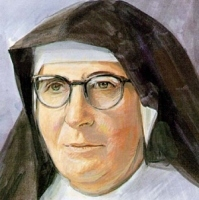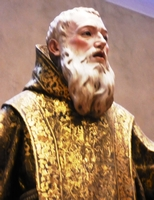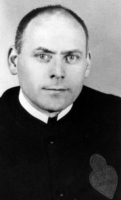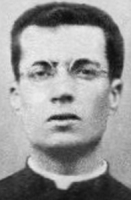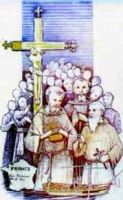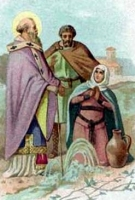Bl. Zepherin Namuncura
Feastday: August 26
Birth: 1886
Death: 1905
Zepherin Namuncura was the eighth of twelve children of the chief of the Araucano Indians of the Argentine Pampas, Chief Manuel Namuncura.Zepherin's ambition was to lead his people to the religion of the one true God. When Zepherin was two, his father gave him to the Salesian priest, Father Dominic Milanesio, telling him that he was giving this son, the future leader of his people, to be brought up in the white man's religion. Zepherin was educated at the Salesian mission school in Buenos Aires. At the age of seventeen, he went into the seminary where he studied hard enough to become second in his class. Zepherin was also growing in virtue and was often found in front of the Blessed Sacrament.
On September 24, 1903, with the permission of his Superiors, Zepherin organized a procession in honor of Our Lady of Mercy. That night he fell into bed tired from his day's labor. He awoke coughing and spitting up blood. Zepherin had tuberlosis. In April of 1904, Zepherin accompanied Archbishop Cagliero to Rome where it was thought that the warm dry air might be good for his health.
In March of 1905, Zepherin took a sudden turn for the worse. He lost weight alarmingly, and seemed to be often in pain. His director wrote, "He got worse day by day, yet he was never impatient. He suffered, but he held onto his cross generously." In April, Zepherin was transferred to the hospital run by the Brothers of God in Rome. Here he bore his cross of suffering heroically, constantly praying the Rosary for his people. This saintly seminarian died on the morning of May 11, at the age of eighteen, surrounded by several of the brothers who were praying for him. He was buried in Rome, but at the insistence of his people, his body was taken back to Patagonia in 1924 and buried at the Salesian school of Fortin Mercedes. Zepherin was declared Venerable by Pope Paul VI in 1972.
Ceferino Namuncurá (August 26, 1886 – May 11, 1905) was a religious student, the object of a Roman Catholic cultus of veneration in northern Patagonia and throughout Argentina.
Saint Mary of Jesus Crucified
Also known as
• Al Qiddisa
• Maram Baouardy
• Maria di Gesu Crocifisso
• Mariam Baouardy
• Marie of Jesus Crucified
• Mary Baouardy
• Maryam Bawardi
• The Little Arab
Profile
Born to Giries Baouardy and Mariam Shahine, a poor Greek Melchite Catholic family. Twelve of her thirteen brothers died in infancy, and Mary's birth was an answered prayer to Our Lady. Her parents died when Mary was only two, and she was raised by a paternal uncle. Moved to Alexandria, Egypt at age eight.
Betrothed in an arranged marriage at age 13, she refused to go along with it, insisting on a religious life. As punishment for her disobedience, her uncle hired her out as a domestic servant, making sure she had the lowest and most menial of jobs. A Muslim servant with whom she worked began to act as her friend with an eye to converting her from Christianity. On 8 September 1858, Mary convinced him she would never abandon her faith; in response he cut her throat and dumped her in an alley. Mary lived, an apparition of the Virgin Mary treated her wound, and she left her uncle's house forever.
She supported herself as a domestic, working for a Christian family and praying. In 1860 she moved in with the Sisters of Saint Joseph. Supernatural events began to occur around her, and the Sisters would not let her join their house. She was taken to the Carmel at Pau by a Sister in 1867, and became a lay sister. Later that year she entered the cloister, taking the name Mary of Jesus Crucified, and making her final profession on 21 November 1871.
She continued to experience supernatural events. She fought off a demonic possession for 40 days, received the stigmata, was seen to levitate, had the gift of prophecy and knowledge of consciences, and permitted her guardian angel to speak through her. Helped found the missionary Carmel of Mangalore, India. Returned to France in 1872. Built a Carmelite monastery in Bethlehem in 1875. Supernatural gifts aside, she was known for her devotion to the Holy Spirit, even sending word to Pope Pius IX that the Spirit was not emphasized enough in seminaries.
Born
5 January 1846 at Abellin, Galilee, Palestine as Mary Baouardy
Died
26 August 1878 at Bethlehem of gangrene following an injury received at the construction site of the Bethlehem monastery
Canonized
17 May 2015 by Pope Francis
Melchizedek the Patriarch
Also known as
Melchisedech
Derivation
Hebrew: king of justice
Article
King of Salem, most probably Jerusalem, and a priest of the Most High God. He came to meet Abram after his victory over Chodorlahomor and his allies (Genesis 14), and on this occasion brought forth bread and wine, blessed Abram, thanked God for the victory, and received tithes of all the spoils. The “bringing forth bread and wine” is interpreted by all the Fathers and Catholic commentators as offering a sacrifice to God, because the phrase which follows, “he was priest of the Most High God,” seems to give the motive why he brought forth bread and wine. According to oriental custom Abram would wish to thank God by sacrifice, and if Melchisedech came to meet Abram because he was a priest of the Most High God, the latter would ask him to offer the sacrifice, and would pay him the tithes for this truly sacerdotal function. Melchisedech is a type of Christ (Psalm 109; Hebrews 7), because of his titles, King of Justice, King of Peace, Priest of the Most High God; and because of his eternal priesthood. Scripture is silent about his lineage, about his birth and death; and in this sense he is “without father, without mother, without genealogy, having neither beginning of days nor end of life” (Hebrews 7). This silence suggests the eternal Son of God and His endless priesthood. He is a type of Christ also because of his superiority to Abram, from whom he received tithes and whom he blessed. In Jewish tradition Melchisedech is commonly identified with Sem; Origen and Didymus held him to have been an angel; some even thought that he Wall an incarnation of the Holy Spirit or the Son of God.
Saint Orontius of Lecce
Also known as
• Orontius the Companion
• Aronzo, Hermes, Horace, Oronzio, Oronzo, Rontius
Profile
Son of Publius, a Roman imperial treasurer; uncle of Saint Fortunatus. Converted by the shipwrecked Saint Paul the Apostle. Roman imperial treasurer upon his father's death. Denounced as a Christian, he was ordered to sacrifice to idols; he refused. He was arrested, stripped of his office, whipped, and exiled to Corinth where he met up with Saint Paul again. Consecrated as the first bishop of his home town of Lecce, Italy. He returned to the town during the persecutions of Nero, was arrested again, and ordered to denounce Christianity. He refused, and after some time in prison managed to get released. He immediately resumed preaching in the areas of Brindisi and Bari. Martyr.
Born
22 in Lecce, Italy
Died
beheaded with an axe on 26 August 68 a couple of miles outside Lecce, Italy
Patronage
• against cholera (his intercession ended an outbreak in 1851)
• Acaya, Italy
• Botrugno, Italy
• Brindisi-Ostuni, Italy, diocese of
• Campi Salentina, Italy
• Diso, Italy
• Lecce, Italy, city of
• Lecce, Italy, archdiocese of
• Lecce, Italy, province of
• Muro Leccese, Italy
• Ostuni, Italy
• Paola, Italy (his intercession saved the city from a siege by the Bruzi)
• Turi, Italy (hid from his persecutors in a cave there; appeared in a vision there in answer to prayers, and his intercession ended a plague in the city c.1657
Saint Jeanne Elizabeth des Bichier des Anges
Profile
Daughter of Antony Bichier, lord of Agnes, and Marie Augier de Moussac. From ages ten through nineteen she was educated at a convent at Poitiers, France. When her father died, she returned home to keep her family's property from being confiscated by the state. She won the court battle to retain the property, and she and her mother moved to La Guimetiere.
The town still suffered the effects of the French Revolution; it didn't even have a priest, much less religious communities. Jeanne Elizabeth gathered the remaining faithful together to pray, read Scripture, and sing hymns. Lived for a while with the Carmelites and the Society of Providence to learn about religious life firsthand.
She soon heard of Saint Andrew Fournet, who practiced a similar ministry in a nearby city; in 1797 she met him, and asked for his help. The two quickly became friends, and together founded the Sisters of the Cross (Sisters of Saint Andrew) to care for the sick and the poor, and to help educate the people of rural France. Jeanne Elizabeth was the first superior of the community, and by 1830 the community had sixty houses scattered throughout France. A men's congregation, Priests of the Sacred Heart of Betherran was formed alongside the Sisters.
Born
5 July 1773 at La Blanc, Charente, France
Died
26 August 1838 La Puye, Vienne, France of natural causes
Canonized
6 July 1947 by Pope Pius XII
Blessed Maria Corsini Beltrame Quattrocchi
Profile
Daughter of Angiolo Corsini, a royal army captain of grenadiers, and Giulia Salvi. Due to her father's military postings, she lived in the Italian cities of Pistioa, Florence, Arrezo and Rome by the time Maria was nine. Initially enrolled in a Rome parochial school, her father transferred Maria to public school after one of the nuns bad-mouthed the king. She served as a volunteer Red Cross nurse during World War I. Catechist to women parishioners. Married to Blessed Luigi Beltrame Quattrocchi. Mother of four. During World War II, their home became a shelter for refugees. Professor, and writer on education. Member of Women's Catholic Action. Noted speaker to women's lay groups. Widow.
Born
24 June 1884 at Florence, Italy
Died
26 August 1965 in Serravalle, Arezzo, Italy of natural causes
Beatified
• 21 October 2001 by Pope John Paul II
• her beatification miracle involved the healing of a young man with a severe circulatory disorder; he is now a neuro-surgeon in Milan, Italy
Our Lady of Czestochowa
Also known as
• Black Madonna of Czestochowa
• Czarna Madonna
• Hodegetria
• Imago thaumaturga Beatae Virginis Mariae Immaculatae Conceptae
• Matka Boska Czestochowska
• One Who Shows the Way
Profile
A revered four-foot high, wood and canvas icon of the Blessed Virgin Mary housed at the Jasna Góra Monastery in Czestochowa, Poland. In the image, Mary, dressed in fleur-de-lis robes, directs attention away from herself and toward Jesus. The Child Jesus raises his right hand in a blessing to the viewer while holding the gospels in his left hand. It was created by an unknown artist some time prior to 1430, possibly as early as the 6th century; it was badly damaged by Hussite raiders in 1430 and had to be restored. The images is credited with saving the Jasna Góra Monastery from invading Swedes. King John II Casimer crowned the images as Queen and Protector of Poland on 1 April 1652. Pope Clement XI issued a Canonical Coronation of the image on 8 September 1717. Another Canonical Coronation was issued on 22 May 1910 by Pope Pius X. Yet another was issued by Pope John Paul II on 26 August 2005.
Patronage
Poland
Blessed Juan Segura Rubira
Profile
The son of a school teacher, the nephew of a parish priest, Juan was baptized at the age of five days, and eventually followed the paths of both his elders. He graduated in 1899, and became a teacher for the next 20+ years. In 1921, at age 39, he finally followed a call to the priesthood, and after some studies was ordained a priest in the diocese of Almería, Spain on 10 June 1922. Director of the Ave María de la Dehesa de la Villa Schools in Madrid, Spain in 1923. During the Spanish Civil War, anti–Catholic forces burned church schools, and killed priests on sight. Father Juan at first went into hiding, but realized that he was endangering the people who sheltered him, he tried to hide in the wild; it didn't work, and he was quickly captured by the militia. Martyr.
Born
21 September 1881 in Purchena, Almería, Spain
Died
26 August 1936 in Cuestas de Belinchón, Cuenca, Spain
Beatified
• 25 March 2017 by Pope Francis
• beatification celebrated in the Palacio de Exposiciones y Congresos de Aguadulce, Almería, Spain, presided by Cardinal Angelo Amato
Blessed Alejandro Más Ginester
Also known as
Father Pedro of Benisa
Profile
Youngest of four children of Francisco Más and Vicenta Ginestar. Joined the Franciscan Capuchins on 1 August 1893 at the convent of Saint Mary Magdalen in Massamagrell, Spain, and made his perpetual vows on 8 August 1897. Priest, ordained on 22 December 1900 in Ollería, Spain. Working primarily in youth ministery and catechesis, he was know for his strict personal adherence to the Rule of his Order. Martyred in the Spanish Civil War.
Born
13 December 1876 in Benisa, Alicante, Spain
Died
• shot 14 times on 25 August 1936 in Vergel, Alicante, Spain
• buried in Denia, Spain
• exhumed on 30 July 1939 and re-interred at the chapel of martyrs of the Capuchin convent of Saint Mary Magdalen in Massamagrell, Spain
Beatified
11 March 2001 by Pope John Paul II
Saint Alexander of Bergamo
பெர்கமோ நகர்ப் புனித அலெக்சாண்டர்
(-303)
இவர் உரோமையை ஆண்டு வந்த தியோகிளசியன் என்பவனுடைய படையில் போர்வீரராக, நூற்றுவர் தலைவராகப் பணிபுரிந்து வந்தார்.
அக்காலத்தில் உரோமை ஆண்டு வந்த மன்னர்களால் கிறிஸ்தவர்களுக்கெதிரான வன்முறைகள் தொடர்ந்து கட்டவிழ்த்து விடப்பட்டன. இதனால் கிறிஸ்தவர்கள் பலவாறாகச் சித்திரவதை செய்யப்பட்டுக் கொல்லப்பட்டார்கள்.
இந்நிலையில் உரோமையை ஆண்டு வந்த தியோகிளசியன் என்ற மன்னன் தனக்கு கீழ் பணிபுரிந்து வந்த அலெக்சாண்டரிடம் கிறிஸ்துவைப் பின்பற்றுகிறவர்களைக் கூண்டோடு அளிக்குமாறு கட்டளை பிறப்பித்தான். இதற்கு இவர் மறுப்புத் தெரிவித்தார். அவன் ஏன் என்று கேட்டபொழுது, "நான் நம்பிக்கை கொண்டிருக்கும் கிறிஸ்துவின்மீது நம்பிக்கை கொண்டிருக்கும் யாரையும் நான் துன்புறுத்துவதில்லை" என்று உறுதியாகச் சொன்னார்.
இதனால் வெகுண்டெழுந்த மன்னன் கி.பி.303 ஆண்டு இவரைக் கொலை செய்தான்.
இவர் பெர்கமோ நகரின் பாதுகாவலராக இருக்கிறார்.
Also known as
Alessandro da Bergamo
Additional Memorial
22 September (Eastern Orthodox)
Profile
Imperial Roman centurian, possibly in the Theban Legion. Martyred both for his faith, and probably for refusing to martyr other Christians. Legend says that he fled his legion, had a series of captures and narrow escapes, preaching on the run and converting many before finally being caught and beheaded, but those documents are likely pious fiction.
Died
beheaded c.287
Patronage
• Bergamo, Italy, city of
• Bergamo, Italy, diocese of
• Capriate San Gervasio, Italy
• Cervignano d'Adda, Italy
Representation
• lily
• military standard with a white lily
• palm of martyrdom
• Roman soldier
• soldier on horseback
Blessed Levkadia Harasymiv
Also known as
• Levkadia Herasymiv
• Leukadia, Laurentia, Lavrentia, Lorenza, Leucadia
Additional Memorial
27 June as one of the Martyrs Killed Under Communist Regimes in Eastern Europe
Profile
Greek Catholic. Entered the Sisters of Saint Joseph in 1931, taking her vows in 1933. Arrested for her faith by the NKVD in 1951, and sent to Borislav (in the modern Czech Republic), then exiled to Tomsk, Siberia. She contracted tuberculosis, and was relocated to Kharsk, Siberia on 30 June 1952. Martyr.
Born
30 September 1911 at Rudnyky, Lviv District, Ukraine as Levkadia Harasymiv
Died
28 August 1952 of tuberculosis and overwork at Kharsk, Tomsk Region, Siberia, Russia
Beatified
27 June 2001 by Pope John Paul II in Ukraine
Blessed Jacques Retouret
Profile
Born to a family of merchants, Jacques received an education and was known as a lover of books. Joined the Carmelites of the Ancient Observant at age 15. Priest. A popular preacher, his health forced him to limit his mission work. Arrested at the convent at Limoges, France, he was ordered deported to French Guinea, imprisoned on a ship in the harbor of Rochefort, France and left to die as part of the anti-Catholic persecutions of the French Revolution. One of the Martyrs of the Hulks of Rochefort.
Born
15 September 1746 in Limoges, Haute-Vienne, France
Died
26 August 1794 aboard the prison ship Deux-Associés, in Rochefort, Charente-Maritime, France
Beatified
1 October 1995 by Pope John Paul II
Blessed Jean of Caramola
Also known as
Giovanni
Profile
Jean moved to Italy in 1300, which had been declared a Holy Year. Benedictine hermit in a cave on Mount Caramola, Basilicata, Italy. Cistercian lay-brother at the abbey of Santa Maria del Sagittario, Naples, Italy; he was so dedicated to a holy silence that most people thought he was a mute. Miracle worker.
Born
c.1280 in Toulouse, France
Died
• 26 August 1339 at the abbey of Santa Maria del Sagittario in Naples, Italy of natural causes
• interred in a chapel dedicated to him in the abbey
• body found incorrupt in 1500
• relics moved to the church of San Giovanni Battista di Chiaromonte in 1808
• body found incorrupt in 2002
Saint Teresa de Gesu, Jornet y Ibars
புனிதர் தெரெசா ஜோர்னெட் இபார்ஸ்
(St. Teresa Jornet Ibars)
கன்னியர்/ நிறுவனர்:
(Virgin/ Founder)
பிறப்பு: ஜனவரி 9, 1843
அய்டோனா, ல்லேய்டா, ஸ்பெய்ன் அரசு
(Aytona, Lleida, Kingdom of Spain)
இறப்பு: ஆகஸ்ட் 26, 1897 (வயது 54)
லிரியா, வலென்சியா, ஸ்பெய்ன் அரசு
(Liria, Valencia, Kingdom of Spain)
ஏற்கும் சமயம்:
ரோமன் கத்தோலிக்க திருச்சபை
(Roman Catholic Church)
முக்திபேறு பட்டம்: ஏப்ரல் 27, 1958
திருத்தந்தை 12ம் பயஸ்
(Pope Pius XII)
புனிதர் பட்டம்: ஜனவரி 27, 1974
திருத்தந்தை ஆறாம் பவுல்
(Pope Paul VI)
பாதுகாவல்:
"கைவிடப்பட்ட முதியோரின் சின்னஞ்சிறு சகோதரிகள் சபை" (Little Sisters of the Abandoned Elderly)
ஆன்மீக சபைகளால் மறுக்கப்பட்ட மக்கள் (People rejected by religious orders)
முதியோர் (Elderly people)
நினைவுத் திருநாள்: ஆகஸ்ட் 26
புனிதர் தெரெசா ஜோர்னெட் இபார்ஸ், ஸ்பேனிஷ் ரோமன் கத்தோலிக்க மறைப்பணியாளரும், "கைவிடப்பட்ட முதியோரின் சின்னஞ்சிறு சகோதரிகள்" (Little Sisters of the Abandoned Elderly) என்ற சபையின் நிறுவனரும் ஆவார்.
ஸ்பெயின் நாட்டின் “ல்லேய்டா” (Lleida) பிராந்தியத்தின் “அய்டோனா” (Aytona) எனும் சிறு நகரில், 9 ஜனவரி 1843ல் விவசாய குடும்பமொன்றில் பிறந்த இபார்ஸின் தந்தை பெயர் “ஃபிரான்சிஸ்கோ ஜோஸ் ஜோர்னேட்” (Francisco José Jornet) ஆகும். தாயாரின் பெயர், “அன்டோனியிட்டா இபார்ஸ்” (Antonieta Ibars) ஆகும்.
சிறுவயதிலிருந்தே எழைகளின்பால் தீவிர பற்று கொண்ட இவர், பல துன்பங்களுக்கு உட்படுத்தப்பட்டார். அனைத்து துன்பங்களையும் பொறுமையோடு எதிர்கொண்டார். ஏழைகளின் நிலை கண்டு எப்போதுமே கவலை கொண்டிருந்தார்.
இவர் சிறுவயதிலிருந்து, தான் ஓர் துறவியாக வேண்டுமென்று ஆசை கொண்டார். தன் விருப்பத்தை பல துறவற இல்லத்தில் தெரிவித்தார். ஆனால் இவரை, துறவறத்திற்கு சேர்த்துக்கொள்ள யாரும் முன்வரவில்லை. எந்த துறவற சபையினரும் அவரை ஏற்றுக்கொள்ளவில்லை. இதனால் ஓர் ஆசிரியராக படித்து, பின்னர் பள்ளியில் ஆசிரியர் பணியை செய்தார். தமது பத்தொன்பது வயதில் “பார்சிலோனா” (Barcelona) நகரில் ஆசிரியை பணி செய்கையில், துறவு வாழ்க்கைக்கு தாம் அழைக்கப்படுவதாக உணர்ந்தார்.
கி.பி. 1868ம் ஆண்டு, “பர்கோஸ்” (Burgos) நகருக்கு அருகேயுள்ள “எளிய கிளாரா” (Poor Clares) மடத்தில் இணைய விண்ணப்பித்தார். ஆனால் அப்போதிருந்த ஆன்மீகத்துக்கேதிரான சட்டங்கள், அவரை சபையில் இணைய தடுத்தன. அதனால், பின்னர் கி.பி. 1870ம் ஆண்டு, “மதச்சார்பற்ற கார்மேல்” (Secular Carmelites) சபையில் உறுப்பினராக இணைந்தார்.
அவரது தந்தையின் இறப்பு மற்றும் அவரைப் பீடித்த ஒரு கடுமையான நோய் காரணமாக, அவர் நீண்ட காலத்திற்கு தமது வீட்டிலேயே தங்க நேரிட்டது. பின்னர், தமது ஆன்மீக வழிகாட்டியின் ஆலோசனைகளின்படி, பிராந்தியத்திலுள்ள முதியோரை அழைத்து வந்து சரியாக அவர்களை கவனிக்க ஆரம்பித்தனர். கி.பி. 1872ம் ஆண்டு, இதற்கான முதல் இல்லத்தை “பர்பாஸ்ட்ரோ” (Barbastro) என்னும் இடத்தில் தொடங்கினார். அவரது சொந்த சகோதரியான மரியா இதற்கு உதவினார்.
நாளடைவில் தன் விருப்பத்தை, தன்னுடைய ஆன்ம வழிகாட்டியிடம் தெரிவித்தார். அவர் காட்டிய வழியில் சென்ற தெரசா, கி.பி. 1872ம் ஆண்டு பார்பஸ்ட்ரோ (Barbastro) என்ற ஊரில், ஒரு துறவற சபையை தொடங்கினார். இச்சபைக்கு "கைவிடப்பட்ட முதியோரின் சின்னஞ்சிறு சகோதரிகள்" (Little Sisters of the Abandoned Elderly) என்ற பெயரை சூட்டினார்.
கி.பி. 1873ம் ஆண்டு, மே மாதம், 8ம் தேதி, “வலென்சியா” (Valencia) நகரில் தமது சபையின் தலைமை இல்லத்தை நிறுவினார். சபையின் தலைமைப் பொறுப்பையும் தாமே ஏற்றார். தமது சபையின் சகோதரிகளிடம், ஏழைகளுக்காக தமது வசதிகளை தியாகம் செய்யுமாறு கற்பித்தார். கி.பி. 1887ம் ஆண்டு, திருத்தந்தை “பதின்மூன்றாம் லியோ” (Pope Leo XIII) சபைக்கான அங்கீகாரத்தை வழங்கினார்.
கி.பி. 1897ல், ஸ்பெயின் நாட்டில் காலரா (Cholera) நோய் பரவியது. இந்நோயால் பாதிக்கப்பட்டோருக்கு உதவிட இவரும் இவரது சபையின் சகோதரிகளும் தீவிரமாக செயல்பட்டனர். இம்முயற்சிகளில் மிகவும் மனம் தளர்ந்த தெரேசா சபையின் தலைமைப் பொறுப்பிலிருந்து ஓய்வு பெற்றார். மிகவும் தளர்ச்சியடைந்த தெரெசா, காசநோய் (Tuberculosis) பாதிக்கப்பட்டு, கி.பி. 1897ம் ஆண்டு, ஆகஸ்ட் மாதம், 26ம் தேதி “லிரியா” (Liria) நகரில் மரணம் அடைந்தார்
Also known as
Teresa of Jesus Ibars
Profile
Raised on a farm. Teacher at Lérida. Tried to join the religious life, but was refused. At the suggestion of her spiritual director, she founded the Little Sisters of the Poor at Barbastra on 27 January 1872. The congregation expanded to 58 houses in Teresa's lifetime.
Born
9 January 1843 at Aytona, Lleida, Spain
Died
26 August1897 in Liria, Valencia, Spain of natural causes
Canonized
27 January 1974 by Pope Paul VI
Patronage
people rejected by religious orders
Saint Anastasius the Fuller
Profile
Born a wealthy Aquileian noble family. After reading Saint Paul's advice to the Thessalonians that it's best to work with your hands, he became a fuller at Spalato, Dalmatia (modern Split, Croatia). Martyred in the persecutions of Diocletian when he painted a cross on his shop door and openly practised his faith.
Died
• drowned with a weight around his neck in 304 in Salona, Dalmatia (part of modern Croatia)
• his body was recovered, brought back to Salona, and a church was built there in his honour
• relics transferred to Spalato (modern Split, Croatia) in the 7th century
Patronage
• fullers
• weavers
Blessed Fèlix Vivet Trabal
Profile
Son of a building contractor. Studied in Rocafort, Barcelona, Spain and Campello, Alicante, Spain. Salesian brother, making his vows in 1928 in Sarrla, Spain. Studied theology at the Gregorian University in Rome, Italy. Martyred in the Spanish Civil War.
Born
23 January 1911 in San Feliu de Torelló, Barcelona, Spain
Died
shot on 25 August 1936 on the side of the road with his father and brother outside Esplugues, Barcelona, Spain
Beatified
11 March 2001 by Pope John Paul II
Blessed Herluin
Profile
Raised to be a soldier, and served as a knight at the court of the Count of Brionne, France. He left the life of arms to found a monastery on his estate at Bonneville, France. Benedictine monk. Abbot at Bonneville. Moved his community to a new home on the banks of the River Bec in 1040. Abbot to Archbishop Lanfranc and Saint Anselm of Canterbury; the three together made their house a center of learning in Christendom.
Born
Normandy (in modern France)
Died
1078 of natural causes
Blessed Stanislaus Han Jeong-Heum
Additional Memorial20 September as one of the Martyrs of Korea
Profile
Layman martyr in the apostolic vicariate of Korea.
Born
1756 in Gimje, Jeolla-do, South Korea
Died
26 August 1801 in Gimje, Jeolla-do, South Korea
Beatified
15 August 2014 by Pope Francis
Blessed Juan Urgel
Profile
Mercedarian friar. Elected Master General of the Mercedarians on 8 September 1492; he served for 21 years. Founded several monasteries in Spain and northern Africa. Noted for his personal piety in the midst of his administrative and missionary work.
Died
26 August 1513 in the Mercedarian convent in Barcelona, Spain of natural causes
Blessed Margaret of Faenza
Also known as
• Margarita of Faenza
• Margherita of Faenza
• Marguerite of Faenza
Profile
Benedictine Vallumbrosan nun at Saint John the Evangelist convent near Florence, Italy, where she eventually became abbess. Spiritual student of Saint Humilitas.
Born
at Faenza, Italy
Died
1330 of natural causes
Blessed Ioachim Watanabe Jirozaemon
Also known as
Joaquín Watanabe Jirozaemon
Profile
Married layman in the diocese of Fukuoka, Japan. Martyr.
Born
c.1551 in Yatsushiro, Kumamoto, Japan
Died
26 August 1606 in prison Yatsushiro, Kumamoto, diocese of Fukuoka, Japan
Beatified
24 November 2008 by Pope Benedict XVI
Saint Bregwin of Canterbury
Profile
Noted spiritual teacher. Archbishop of Canterbury, England in 759. Received the pallium from Pope Paul I in 761. Bregwin's letters to Saint Lull of Mainz survive.
Born
Saxony (in modern Germany)
Died
• 764 of natural causes
• buried in the Chapel of Saint John the Baptist, east end of Canterbury Cathedral
Saint Victor the Martyr
Also known as
Vitores
Profile
Hermit near Burgos, Spain. At the command of an angel, he returned to Cereza, Spain to preach Christianity to the Moors who were laying seige to the city. Martyr.
Born
Cereza, Spain
Died
crucified c.950 in Spain
Blessed Jean Bassano
Profile
Canon regular. Celestine Benedictine at Paris, France. Spiritual director of Saint Colette. Held several offices in his congregation, and worked to establish it in England and the Aragon region of Spain.
Born
1360 at Besançon, France
Died
1445 of natural causes
Saint Secundus the Theban
Profile
Soldier. Martyr. Member of the Martyrs of the Theban Legion.
Died
martyred c.287 in Agaunum (modern St-Maurice-en-Valais, Switzerland
Saint Eleutherius of Auxerre
Profile
Bishop of Auxerre, France in 532; he served for 29 years. Assisted at the four Councils of Orleans.
Died
561
Saint Irenaeus of Rome
Profile
Martyred during the persecutions of Valerian.
Died
drowned c.258 in the sewers of Rome, Italy
Saint Victor of Caesarea
Also known as
Vittore
Profile
Martyr.
Died
crucified in Caesarea, Mauritania (in modern Algeria)
Saint Abundius the Martyr
Profile
Martyred during the persecutions of Valerian.
Died
drowned c.258 in the sewers of Rome, Italy
Saint Rufinus of Capua
Profile
Fifth-century bishop of Capua, Italy.
Died
relics enshrined in the cathedral of Capua, Italy
Blessed Vyevain of York
Profile
Archbishop of York, England in the latter 13th century.
Died
1285 of natural causes
Saint Maximilian of Rome
Profile
Martyr.
Died
cemetery of Basilla on the Via Salaria Antica outside Rome, Italy
Saint Pandwyna
Profile
Nun. The church in Eltisley, England is dedicated to her.
Born
Irish
Died
c.904 of natural causes
Saint Felix of Pistoia
Also known as
Felix of Pistoja
Profile
Ninth-century hermit in Pistoia, Italy.
Saint Elias of Syracuse
Profile
Monk. Bishop of Syracuse, Sicily.
Died
660
Martyrs of Celano
Profile
Three Christians, Constantius, Simplicius and Victorinus, martyred in the same area at roughly the same time. That's really all we know, though it didn't stop writers in later centuries from inventing colourful histories, making them a father and sons, adding saintly family members, earthquakes, close escapes, etc.
Died
• c.159 in the Marsica region of Italy
• at some point their relics were interred under the main altar of the San Giovanni Vecchio church in the Collegiata di Celano
• relics authenticated in 1057 by Pope Stephen IX
• the city was depopulated in 1222; when it was re-built, the relics were re-enshrined in the church of San Vittorino on 10 June 1406
Patronage
Celano, Italy
Martyred in the Spanish Civil War
Thousands of people were murdered in the anti-Catholic persecutions of the Spanish Civil War from 1934 to 1939. I have pages on each of them, but in most cases I have only found very minimal information. They are available on the CatholicSaints.Info site through these links:
• Blessed Emilio Serrano Lizarralde
• Blessed Francesc Casademunt Ribas
• Blessed Josep Maria Tolaguera Oliva
• Blessed Luis Valls Matamales
• Blessed María de Los Ángeles Ginard Martí
• Blessed Pere Sisterna Torrent




























